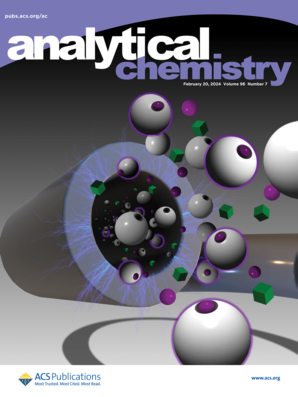Rational Design of Long-Circulating Bright Fluorescent Probe for In Vivo Imaging of Amyloid-β Plaques in Alzheimer's Disease.
IF 6.7
1区 化学
Q1 CHEMISTRY, ANALYTICAL
引用次数: 0
Abstract
Alzheimer's disease (AD) is a neurodegenerative disorder characterized by the pathological accumulation of amyloid-β (Aβ) plaques, which serve as crucial biomarkers for disease diagnosis and therapeutic evaluation. While fluorescence imaging has emerged as a powerful technique for Aβ detection, current probes face limitations in clinical application due to insufficient photostability and short blood half-life, resulting in compromised signal-to-noise ratios (SNRs) and imaging resolution. Herein, two bright quinoxalinone-based fluorescent probes (QNO-AD-PEGs) were presented, which incorporate hydrophilic poly(ethylene glycol) (PEG) chains for enhanced biocompatibility and an Aβ-specific N,N-dimethylaminophenyl recognition unit. QNO-AD-PEG1 demonstrated exceptional binding affinity for Aβ42 aggregates (Kd = 42 nM) and a remarkable 49-fold fluorescence enhancement upon target engagement, with a quantum yield (ΦAβ) of 11.45%. In vivo imaging revealed that QNO-AD-PEG1 effectively crossed the blood-brain barrier (BBB) and exhibited a prolonged half-life (315 min). Notably, the probe successfully visualized age-dependent Aβ plaque progression in AD mouse models. This study presents a significant breakthrough in molecular imaging for neurodegenerative diseases, offering a versatile tool for both fundamental AD research and potential clinical applications.合理设计用于阿尔茨海默病淀粉样β斑块体内成像的长循环明亮荧光探针。
阿尔茨海默病(AD)是一种以淀粉样蛋白-β (a β)斑块的病理积累为特征的神经退行性疾病,淀粉样蛋白-β斑块是疾病诊断和治疗评估的重要生物标志物。虽然荧光成像已经成为一种强大的检测a β的技术,但由于光稳定性不足和血液半衰期短,目前的探针在临床应用中面临限制,导致信噪比(SNRs)和成像分辨率下降。本文提出了两种基于喹诺沙林酮的荧光探针(qno - ad -PEG),它们含有增强生物相容性的亲水聚乙二醇(PEG)链和a β特异性N,N-二甲氨基苯基识别单元。QNO-AD-PEG1对a - β42聚集体具有特殊的结合亲和力(Kd = 42 nM),在与目标结合时荧光增强了49倍,量子产率(ΦAβ)为11.45%。体内成像显示QNO-AD-PEG1有效地穿过血脑屏障(BBB),并表现出延长的半衰期(315分钟)。值得注意的是,该探针成功地可视化了AD小鼠模型中年龄依赖性的Aβ斑块进展。这项研究在神经退行性疾病的分子成像方面取得了重大突破,为阿尔茨海默病的基础研究和潜在的临床应用提供了一个多功能的工具。
本文章由计算机程序翻译,如有差异,请以英文原文为准。
求助全文
约1分钟内获得全文
求助全文
来源期刊

Analytical Chemistry
化学-分析化学
CiteScore
12.10
自引率
12.20%
发文量
1949
审稿时长
1.4 months
期刊介绍:
Analytical Chemistry, a peer-reviewed research journal, focuses on disseminating new and original knowledge across all branches of analytical chemistry. Fundamental articles may explore general principles of chemical measurement science and need not directly address existing or potential analytical methodology. They can be entirely theoretical or report experimental results. Contributions may cover various phases of analytical operations, including sampling, bioanalysis, electrochemistry, mass spectrometry, microscale and nanoscale systems, environmental analysis, separations, spectroscopy, chemical reactions and selectivity, instrumentation, imaging, surface analysis, and data processing. Papers discussing known analytical methods should present a significant, original application of the method, a notable improvement, or results on an important analyte.
 求助内容:
求助内容: 应助结果提醒方式:
应助结果提醒方式:


